Safe Toys List
Santa’s busy in his workshop, so while he and the Elves are getting ready for Christmas deliveries, we “present” a list that YOU might want to check twice before heading out to complete your side of the shopping, because December is:
Safe Toys and Celebration Month

The public safety non-profit, which has been keeping an eye out for our kids since 1973, is W.A.T.C.H., which stands for “World Against Toys Causing Harm”. They’ve done the legwork for parents all over the country with their list of the “10 Most Dangerous Toys of 2016”, designed to help moms, dads and Santa pick out the perfect and safest gifts this holiday. Please take a moment to look it over. You might even want to share this link with friends and family, to ensure that their gift giving choices for your kids are in line with toy safety. Check out the list here.
Luckily the “bad” list is small and we can browse through a very long “good” list on Good Housekeeping’s website “Good” toys for 2016. Their experts vetted 500-plus new toys for safety, quality and skill-building and compiled their list of Toy Award Winners, they then asked the toughest critics of all- kids – to name the “bestest” of them all. Click here to start making your list.
Have a SAFE and Happy Holiday Season.
Safe Toys and Celebration Month
‘Tis the season when gift giving is (almost) as much fun as receiving, and because it’s Safe Toys and Celebration Month, let’s do our best to make sure that the gifts our children SEE on Christmas and Hanukkah are safe and fun for them all year long.
According to the U.S. Consumer Product Safety Commission, nearly 252,000 toy-related injuries were treated in emergency rooms in 2014, and almost half of those affected the head or face. The commission reports that 1 in 10 of those children’s eye injuries treated in the ER trace back to toys. Some propelling toys like paintball guns and darts have the potential to cause serious eye injuries and even permanent vision loss.
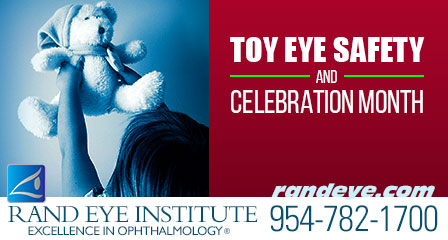
When choosing a toy for a child consider these Top Toy Safety Tips:
- Avoid toys with sharp, protruding or projectile parts that could end up in their eyes.
- Make sure children are supervised by an adult when playing with toys or games that could cause an injury, especially to the eyes.
- Always provide children with the appropriate protective eyewear with polycarbonate lenses if recommended by the manufacturer of the toy or sporting equipment. Click here to learn which protective eyewear is recommended for your child’s sport.
- Keep toys made for older children away from younger children, who may accidentally hurt themselves, or suffer an injury to their eyes or face.
If your child does experience an eye injury during playtime, seek immediate medical attention from an ophthalmologist or medical eye doctor.
Have a safe and happy Holiday Season and a wonderful New Year.
Diabetic Eye Disease Month – Stay on T.R.A.C.K.
November is Diabetic Eye Disease Month, a good time to update your Rand EYE-Q.
If you have diabetes, you should know that it can affect the retina, when that occurs the result is Diabetic Retinopathy, the number one cause of blindness in the world. Even patients with well-controlled diabetes can develop diabetic changes in their retina over the years.
Here are some common signs and symptoms of diabetic retinopathy:
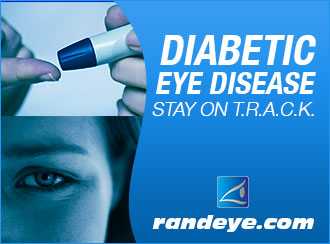
- Transient blurred vision, often linked to blood sugar level fluctuation
- Floaters and flashes of light
- Gradual or sudden loss of vision or blind spots in the vision
Over time, diabetes can affect the circulatory system of the retina. In this phase, the arteries in the retina become weakened and leak, forming small dot-like hemorrhages. If the disease progresses, leaking vessels can lead to swelling (edema) in the retina and decreased vision.
There is treatment depending upon the stage of the disease and the specific problem that requires attention. Prevention comes about when those with diabetes are able to maintain “normal” blood sugar levels more often. Diet and exercise play important roles in the overall health of those with diabetes.
Diabetics should continue this discussion with their ophthalmologist. Schedule regular eye examinations and learn their options. More than 26 million children and adults in the U.S. alone are affected by diabetes but it doesn’t have to be vision changing. Follow some simple suggestions:
Stay on T.R.A.C.K. with your diabetes by:
- Taking your medications.
- Reaching and maintaining a healthy weight.
- Adding physical activity to your daily routine.
- Controlling your blood sugar, blood pressure, and cholesterol.
- Kicking the smoking habit.
Schedule a comprehensive eye exam at Rand Eye Institute to stay ahead of vision problems.
Happy Thanksgiving 2016
As we celebrate with friends and family this Thanksgiving, whether near or far, we wish to give thanks for being part of our Rand Family of patients and ophthalmic community. We thank you for the privilege of serving you this year and look forward to seeing you again soon.
From the Rand Eye family to yours, have a Happy Thanksgiving!

Diabetic Eye Disease Month – Hemoglobin A1C Test
It’s Diabetic Eye Disease Month and Rand Eye is LOOKING out for you. DYK that diabetes is one of the leading causes of irreversible blindness in the United States and the most common cause of blindness in people younger than age 65?
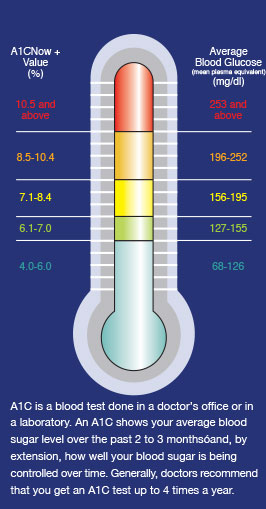
It doesn’t have to be that way if you know your Rand EYE-Q. There is a test commonly known as “A Report Card for Diabetes Control” called The Hemoglobin A1C Test, an important test that measures your blood sugar intake levels providing your true average.
The Hemoglobin A1C Test can tell you just how well you’re controlling your diabetes. By keeping your diabetes under tight control, you can significantly reduce the risk of losing your vision to diabetic eye disease. Think of the hemoglobin A1C test as if it were averaging all of your blood sugar readings from the previous three months. You should have the test three to four times a year so that you can monitor and modify your diabetes management plan.
Your Hemoglobin A1C Test reading should be 7.0 or less. Hemoglobin A1C readings above 8.0 are not as good. When the readings are 9.0-12.0 or above, the risk and severity of diabetic complications increases proportionately.
Don’t become a statistic. The American Diabetes Association estimates that 86-million people in the U.S. have pre-diabetes and 9 out of 10 of them don’t even know they have it. Without working to prevent it, 15-30% of will develop type-2 diabetes within a year, which could lead to permanent vision loss. Diabetes can also increase the risk of cataracts and glaucoma, so do your best to feel your best. In our next blog, we’ll share the facts on diabetic retinopathy. #RandEYE-Q #diabetes #diabetesawarenessmonth
National Diabetic Eye Disease Month: Know Your EYE-Q
November is designated as Diabetic Eye Disease Month and if you have diabetes or are newly diagnosed; know that you’re at risk of vision loss. What is the cause and who is most at-risk? Let’s take a look at these important facts and outline ways for you to keep from becoming a statistic.
Diabetes Could Lead to Vision Loss
Diabetes is a disease that affects blood vessels throughout the body. Unfortunately, diabetic damage in the eye, also known as diabetic retinopathy, leads to vision loss when these blood vessels leak fluid or bleed. There is laser treatment that can help control the swelling or growth of abnormal blood vessels, and another treatment that involves injections either in or around the eye. It is recommended that you see your eye care specialist to help you decide which treatment is right for you.

Who is most at risk?
African Americans, Native Americans, Alaska Natives, Hispanic/Latinos and older adults with diabetes are at an especially higher risk of developing diabetic eye disease.
How will EYE know?
Be proactive when it comes to your vision by scheduling a comprehensive dilated eye exam, performed by an ophthalmologist at least once or year. Early detection and timely treatment are extremely important in preventing vision loss to those highly at risk. Diet and exercise also play an important role in the overall health of those with diabetes.
Beat Diabetes by Doing This
If you are diabetic, be sure to monitor and control your blood sugar, it’s the most effective way to avoid damage and loss of vision as well as damage to the rest of your body. A hemoglobin A1C test will assist you and your physician in keeping a report card on your blood sugar control. Read more about this in our next blog.
Carving out a Niche This Halloween and Making it Safe for Kids
Nothing says, “Welcome to Fall” like the orange glow of a pumpkin patch. Time to pick out a healthy, robust pumpkin for your Fall Halloween decorations, and carve out some fun by adding your own decorative design to his mesmerizing mug.
Have fun with your pumpkin this Halloween, but please observe these Halloween Safety Tips first before carving ol’ Jack, courtesy of Rand Eye Institute and The American Academy of Pediatrics.

While carving the pumpkin is a fun family activity that has so many layers, (design, baking pumpkin seeds, carving and construction), remember, small children should never carve pumpkins, let the adults do that. Children can draw his face with markers, or using a paper template, have them suggest where to poke the holes through the paper, so an adult can do the carving.
Consider using a flashlight or glow stick, instead of a real candle to light the inside of the pumpkin. Try using a small battery-operated LED candle, they’re inexpensive, reusable, come in a variety of colors and they flicker just like real candles. A candle left unattended is not only dangerous, but the heat from the candle melts the pumpkin prematurely, no one likes a floppy pumpkin.
So in the 35-year tradition of Rand Eye Vision safety-first tips, use your Rand EYE-Q this Halloween to keep your little ghosts, ghouls and goblins safe!
Halloween Safety Tips 2016
Happy Halloween: Dressing you up with helpful suggestions and important safety tips relating to your child’s vision, from; Rand Eye Institute and The American Academy of Pediatrics.
The Halloween we remember as kids is long gone. Today, in this all-consuming world of multi-tasking, mobile electronics and Pokémon chasing, our kids need to be especially vigilant and aware of their surroundings during Halloween. It’s also up to us as parents to make sure that the trick-or-treaters get only treats. So with that in mind, here are some helpful Halloween tips for kids of all ages:
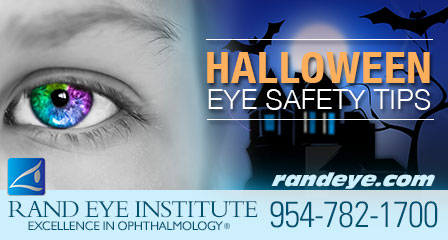
I’m Happy to See You
Masks can block or restrict your child’s vision, consider non-toxic makeup instead. Coming up with an original idea for makeup is a great way to engage your child about the creation of their own costume while helping them to be safer outside.
Lenses and Safety Senses
When it comes to vision, never allow the wearing of decorative contact lenses; colored contacts should always be prescribed by your eye doctor. Obtaining decorative contact lenses without a prescription is both dangerous and illegal and may cause eye infections and/or serious eye problems, leading to permanent vision loss.
Dress Up for Safety
Plan costumes that are bright and reflective. Always add reflective tape or striping to costumes, a flashing necklace or light, and don’t assume all costumes have to be dark. Creating light and reflection alerts an approaching vehicle to slow down for trick-or-treaters. When shopping for costumes and accessories, always look for a label clearly indicating that they are flame resistant. Also, make sure shoes fit well and that costumes are short enough to prevent tripping or getting caught or entangled.
No Cane Do
Be careful of too many accessories like a cane, a sword or a stick. If your child has one, make sure it’s not sharp or too long. Your child could be hurt if they stumble or trip, and they should be using their free hand to hold a working flashlight that has fresh batteries inside.
Be The King of The Mall
And lastly, Trick or Treating doesn’t have to be in the neighborhood. Check with your local shopping mall, many offer safe and well-lit trick-or-treat-streets inside the mall, or consider hosting a Halloween party for the kids at your house.
So use your Eye-Q and have a safe and Happy Halloween from all of us, at Rand Eye Institute.
World Sight Day
See the Good Things We Do, With Your Own Eyes® – On World Sight Day
Thursday October 13th is World Sight Day, but why wait for one day out of 365 to look out for your vision when you can do it everyday? Let’s get out and take an active role towards the care and prevention of eye diseases. Your eyes need to be at the top of your list when it comes to your health and how it affects your lifestyle that’s why this year’s theme is Universal Eye Health.
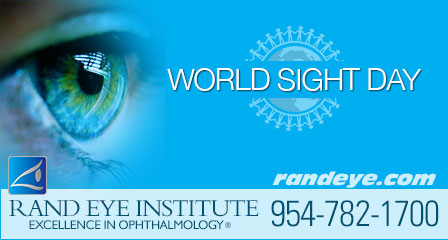
World Sight Day (WSD), an international day of awareness, focuses attention on the global issue of avoidable blindness and visual impairment.
Know Your Rand Eye-Q:
- 4 out of 5 blind people are needlessly impaired, that means 80% of blindness is avoidable.
- About 285 million people are visually impaired worldwide. Preventable causes are as high as 80% of the total global visual impairment burden.
- 90% of the world’s visually impaired people live in developing countries.
Don’t Become a Statistic. Keep Your Vision in Check
The American Academy of Ophthalmology recommends that you have a baseline eye exam at age 40 to help identify signs of eye disease at an early age. If you’re 65 or older, you should have your eyes checked every year or two for signs of the eye-related diseases.
Click Below to Schedule Your Eye Exam Today
Take the first step to clear vision at Rand Eye Institute.
Carving Out the Colors of Fall: A Sight for ALL Eyes
Nothing says, “Welcome to Fall” like the glow of a bright orange pumpkin patch: Jack-o-lanterns lined up as far as the EYE can see! Pick out a nice, healthy and robust pumpkin for your Fall Halloween decorations then carve out some family fun by adding your own decorative design to his mug.

There’s lots to keep an EYE on this month, including the little ones, who’ll be trick-or-treating on Monday Oct. 31st. We’ll have our Halloween Safety Tips for you later this month. Please read them, print them out and share them with your neighbors, because VISION plays the biggest role in the safety of all of our children.
Savor Super Sight 365 Days a Year
We’ll be recognizing World Sight Day on October 13th, but at Rand Eye Institute, we remind you that it’s important to have good vision the other 364 days of the year too, so why not set aside time to have a complete vision screening?
If you have cataracts, consider that cataract surgery can help you to live longer. A recent study by The American Academy of Ophthalmology of 1.5 million patients over a 10-year period, found that nearly 30% had a reduced adjusted hazard of mortality, compared with those who did NOT have cataract surgery. That says, in a nutshell, that having cataract surgery can help you to live a longer, more fulfilling life.
Why is that? Cataract surgery improves the patient’s ability to care for themselves. Through better vision, they remain physically and socially active, interact more with friends and family and have an overall better visual experience. You don’t have to live with cataracts, especially when the FDA has approved laser cataract surgery as safe and effective, and it’s here NOW at The Rand Eye Institute. Click here to schedule your evaluation.
All this vision knowledge we share with you, will help you up your Rand EYE-Q, so that you can have a safe and happy fall season.
